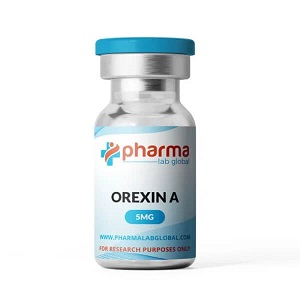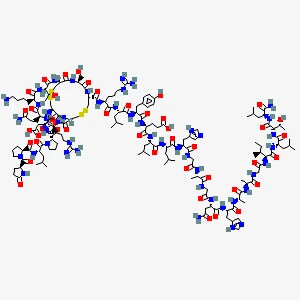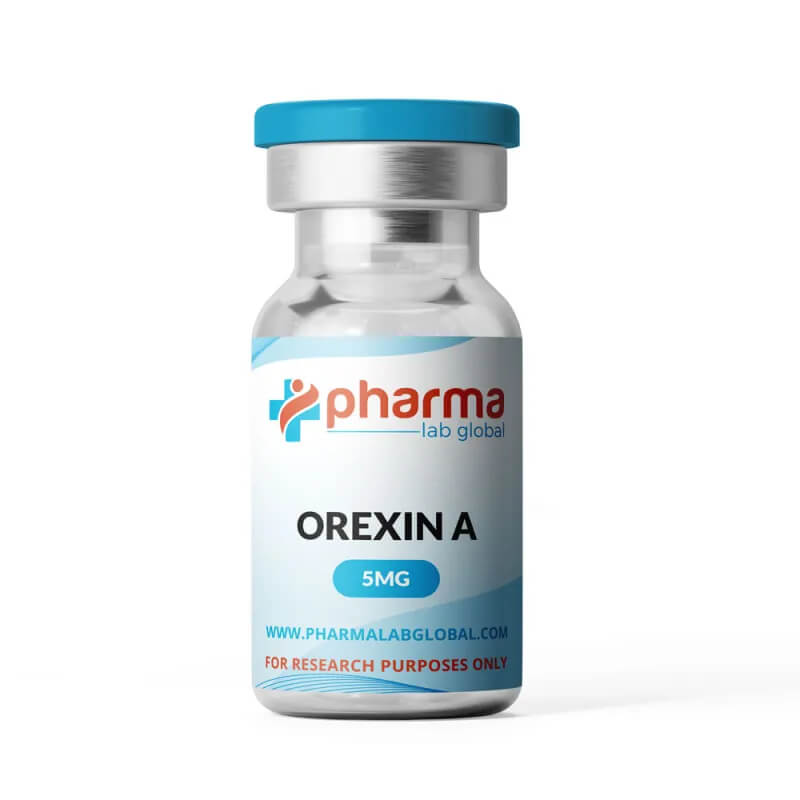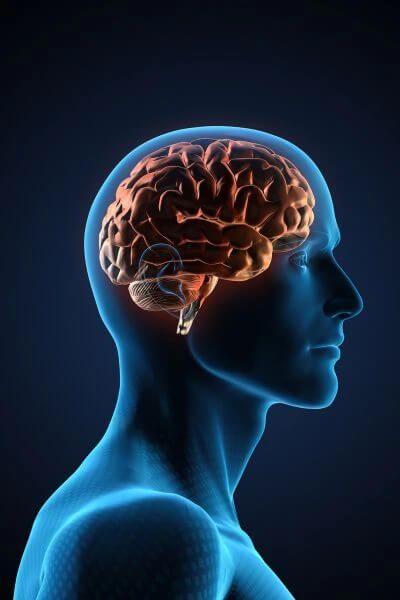Buy Orexin A



Orexin A, a neuropeptide abundantly expressed in the hypothalamic complex, has been known to be involved in sleep-wake regulation and feeding behavior. It belongs to Orexin system that is composed of the peptides Similar in structure and function, OX-A and orexin B are involved in the regulation of normal sleep-wake cycle and energy metabolism.
Orexin A Acts on Orexin Receptors To Induce Wakefulness and to Inhibit Development of Non-Rapid Eye Movement Sleep in Mice This renders Orexin A a candidate for the treatment of sleep disorders, such as narcolepsy.
Furthermore, it modulates reward circuitry and appetite control thereby connecting it to behaviours such as consumption of food and motivation. Its great versatility and multiple functions indicate that the LHA play a key part in brain and body homeostasis.
Molecular Formula: C152H243N47O44S4
Sequence: XPLPDCCRQKTCSCRLYELLHGAGNHAAGILTL
Molecular Weight: 3561.1 g/mol
Orexin A likely has the following potential therapeutic and clinical uses, as suggested by human studies:
Promotes wakefulness
Enhances energy levels
May help with appetite control
Improves cognitive function
Regulates emotional responses
Supports the stress response
Order Orexin A Peptide Vial Also available as vials kits.


Orexin A, derived from hypothalamic neuropeptide synthesis, regulates physiological activity by acting on orexin receptors Orexin Receptor 1 (OX1R) or Orexin Receptor 2 (OX2R) which are G protein-coupled. These receptors are found throughout the brain, especially in areas associated with arousal, energy homeostasis, and reward perception such as the hypothalamus, brainstem, and cortex.
Activation of these receptors increases intracellular second messenger signalling pathways such as calcium ion (Ca(2+)) influx, and cyclic AMP production that may influence neuronal excitability. This further contributes to wakefulness by activating arousal centers in the brain (e.g., locus coeruleus, tuberomammillary nucleus) and inhibiting sleep-promoting regions of the brain.
In addition, Orexin A is known to be implicated also in energy homeostasis including appetite regulation and metabolism. It acts upon the reward system, and consequently on dopamine release, which makes it to be related with motivation and anxiety. This collective action makes Orexin A critical for controlling the equilibrium between sleep, energy and behaviour.
Buy Orexin A UK for study from the first and best research website online PharmaLabGlobal.
Orexin A has been studied in preclinical group of investigators reporting the potential utility of Orexin A as follows:
Promotes Wakefulness
Orexin A increases consciousness through increasing activity in certain areas of the brain that control wakefulness. It has high affinity for the Orexin 1 (OX1R) and Orexin 2 (OX2R) receptors, which are situated in central regions such as the locus coeruleus, hypothalamus and tuberomammillary nucleus. These areas are members of the brain's ascending arousal system and their activation promotes neuronal excitability and neurotransmitter release (including norepinephrine, dopamine, and histamine). This domino effect of influences works to sustain wakefulness and inhibit sleep-promoting cues. Orexin A is also involved in the mediation of the sleep wake cycle and plays a key role in maintaining normal daytime arousal.
Enhances Energy Levels
Orexin A increases energy expenditure through brain arousal and metabolic control. Orexin A also affects energy homeostasis through the stimulation of glucose utilization and elevation of energy burn. It also acts on reward circuits, increasing motivation for physical activity and goal-directed behaviours. Through its association with arousal, metabolism, and motivation Orexin A is a critical component in the regulation of energy expenditure; it continues to promote wakefulness, reduce fatigue and increase motivation even during periods of physical or psychological stress.
Helps with Appetite Control
Orexin is a major appetite-regulating hormone that affects the brain’s hunger and reward centers. It is expressed in the hypothalamic nuclei, which play a pivotal role in the regulation of energy homeostasis and food intake. Orexin A ligates Orexin Receptor 1 (OX1R) and Orexin Receptor 2 (OX2R) that are known to increase motivation for seeking food but are able to promote hunger. It increases the neurotransmitter dopamine in the brain, which helps bring about more pleasure/rewards with food.
Moreover, Orexin has a role in energy homeostasis through stimulated metabolic rate and energy expenditure thereby modulating caloric intake and utilization. By stimulating appetite and energy expenditure at the same time, Orexin is an important part of how we regulate healthy eating and avoid over-eating or under-eating. The participation in appetite regulation also underlines the possibility of its as a therapeutic target for handling obesity, eating disorders and metabolic disorders.
Improves Cognitive Function
Orexin A improves cognitive deficits associated with sleep apnea by activating arousal, attention and memory mechanisms. This activation induces wakefulness, mental clarity and better attention & information processing.
Moreover, Orexin A promotes neuroplasticity through activation of BDNF, an essential element for learning and memory acquisition. Through keeping arousal and focus in balance, Orexin A will thus also increase cognitive performance, especially during cognitive demands which require repeated focus or when fatigued. Its involvement in the modulation of reward-related pathways also contributes to motivation, hence cognitive activity and productivity.
Regulates Emotional Response
Orexin A modulates rewarding pathways as well as the neurochemical dopamine and serotonin release, hence reward and emotional balance. This has beneficial effects on mood and anxiety levels, as well as stress resilience. It also helps to keep your energy and arousal level high so you are emotionally balanced in difficult or high-stress environments.
Supports the Stress Response
Orexin A acts on the hypothalamic-pituitary-adrenal (HPA) axis that controls cortisol, the most important stress hormone. By modulating arousal and energy levels, Orexin A allows someone to feel alert while also feeling emotionally well (focused and not stressed) without having an overreaction of anxiety or stress.
What is the distinction between Orexin A and Orexin B?
1. Structure
2. Receptor Affinity
3. Stability & Function
Is it safe to drink orexin A?
Orexin A is not yet approved for human use, but clinical development for therapeutic purposes is underway. Progress in drug delivery methods and orexin receptor agonist synthesis could lead to treatments based on the mechanisms of action of orexin A. Purchase high quality Orexin A for sale.
Might Orexin A combat addiction?
Based on preclinical and early research, orexin A seems to have some promise in the treatment of addiction. The orexin system is a major modulator of reward, motivation and stress, which all have important influences on addiction.
The action of the orexin system, especially Orexin A, in the reward circuits of the brain (such as the mesolimbic dopamine pathway) that is actually activated by addictive substances such as alcohol, nicotine, opioids)) or cocaine.
The orexin neurons of the hypothalamus, which innervate several regions in the brain known to be important components of the addiction circuitry (including the VTA, NAc and PFC).
These aforementioned orexin-signalling mechanisms are thought to be associated with drug-seeking and relapse behaviors, particularly in the context of stress or drug use-related environmental cues.


Investigate the Effect of Orexin A Antibody on Sleep and Cortisol Balance
This content on the Orexin A Antibody, provided by Pharma Lab Global discusses how the latter has played an important role in examining the relationship between sleep regulation and cortisol balance.
Orexin, a neuropeptide, acts on the hypothalamus-pituitary-adrenal (HPA) axis that mediates wakefulness and response to stress by exerting orexinergic control over cortisol secretion. Sleep and recovery can be disturbed by excessive cortisol levels over time, which makes the research around this very important.

Orexin Deficiency, Cataplexy, and Narcolepsy Type 1
These two cats’ shared genealogy is the subject of this week’s blog which considers how a deficiency in orexin, cataplexy and for narcolepsy type 1 comes about and explains the relationship between changes to loss of REM sleep boundaries as a result of their effects on central nervous system (CNS) function despite an apparent normal level of daytime fatigue.
It explores the role of emotions including or laughter and stress in cataplexy episodes, and how arexin affects metabolism, weight control, as well as long-term health problems like depression and obesity.

The Future of Narcolepsy Treatment
Dive into the latest research on peptide-based therapies against narcolepsy. Existing medications serve primarily to control symptoms such as excessive daytime sleepiness and cataplexy, but the root cause, loss of orexin-producing neurons in the brain, is not targeted. New peptides Orexin, P-21, and BPC-157 are under investigation for ability to reinstate orexin signalling, support neuroregeneration and the balance of neurotransmitters.